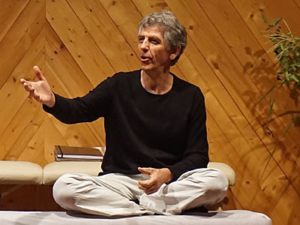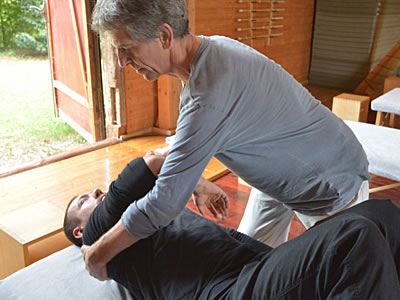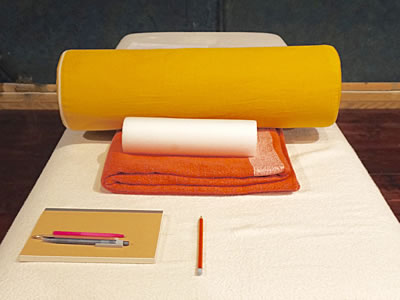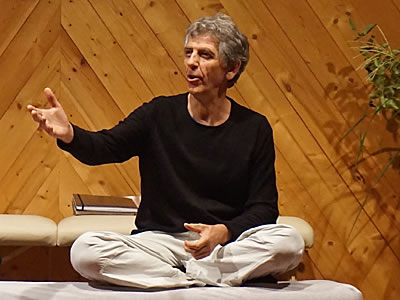Additional information
Alon Talmi and Moshé Feldenkrais
Alon Talmi and Moshé Feldenkrais met for the first time in Paris in 1949 and became very close friends. It was Talmi who played a significant part in Feldenkrais returning to Israel, and in the years 1969 – 1971 Feldenkrais offered training in Tel Aviv for the first time. Talmi was one of the students in this course, one of the first thirteen students (the legendary “Group 13”) along with Mia Segal, Feldenkrais’ very first student, who had been working with him since the 1950s. Feldenkrais didn’t select his students by chance, as related by Eli Wadler in his book: “At any rate it was so that everyone, in regard to his or her work, came to the course with a personal viewpoint of people. Everyone was different from one another. And Moshe thought that this way everyone would donate something to the group, and that’s the way it was, too.” Alon Talmi has remained faithful to this principle of Moshé Feldenkrais, which was evident later on in the selection of his own students (for more on this, see the section “Alon Talmi and his students”). Eli Wadler worked together a lot with Alon Talmi during their mutual training under Feldenkrais. Talmi, who was a chemistry professor at the University of Tel Aviv, left his position after finishing the training program and devoted himself solely to bodywork.
The thirteen students were, in addition to Alon Talmi and Eli Wadler, who had studied drug addiction treatment, the psychiatrist Dr. Shlomo Bracha; the mathematics teacher Yochanan Rywerant (d. 2010); Batya Fabian, who learned how to dance under Isadora Duncan; Myriam Pfeffer (d. 2014), who established Feldenkrais lessons in France; Dr. Chava Shlehav, who for many years was the personal assistant of Feldenkrais and founded the “Child Space” / Chava Shelhav method, and still today organizes training programs in the Feldenkrais method; the musician and yoga instructor Gaby Yaron (d. 1995); the physiotherapist Fanny Loc; Ruthy Alon, founder of Bones for Life® and the Foundation of Movement Intelligence; Dvora Hasdai; Shlomo Efrat; and Bruria Milo (d. 2007).
You can find more about these thirteen students and the quote in the book “Feldenkrais Eli Wadler. Fliessende Bewegung von Kopf bis Fuß in lebendiger Praxis.” Seven of the thirteen students met again in 2007; there is a nice film documentary by Sheth Haim Levy about this get-together, and you can view the trailer on Youtube and the DVD can be purchased directly from Levy. The seven students at the get-together were Eli Wadler, Shlomo Efrat, Yochanan Rywerant, Chava Shelhav, Dvora Hasdai, and Bruria Milo, who died, unfortunately, during the filming. They talk about their work and the time they spent with Feldenkrais during their training.
Alon Talmi put together twenty well-structured FI® lessons. Each lesson is built around a central functional theme that will be examined from different positions, whereas the physical principles that characterize the Feldenkrais method will be adhered to. There is a prehistory and a beautiful description of how during the training program Alon Talmi was chosen by the twelve other students to cautiously ask Feldenkrais what this is all about actually that can be found in Christian Burckhard’s book “Moshé Feldenkrais. Der Mensch hinter der Methode.”
Alon Talmi and his students
Various students of Alon Talmi work today with their own variations on his bodywork: Talmi’s assistant of many years and Feldenkrais instructor Yehudit Silver developed Under the Oak; the culture and social anthropologist Dr. Nurit Sommer combined Talmi’s work with psychotherapeutic approaches; the director and acting instructor Martin Gruber brought it to the performing arts field; and another student was the physician Dr. Katharina Krassnig, just to name a few.
Yehudit Silver calls her work “Under the Oak,” because “alon” in Hebrew means “oak.” She completed her Feldenkrais training under Dr. Chava Shelhav and she worked with Alon Talmi for ten years. During these ten years she developed her own form of FI® lessons, inspired by and in remembrance of her teacher Alon Talmi. All of the lessons are constructed like a tree: the trunk is made up of the lessons Alon Talmi developed, and the branches display a broad spectrum of additional applications and possibilities. Yehudit Silver now offers her wonderful work in Germany and Austria; her next training programs will take place in 2019 in Sankt Peter, Germany, which is close to Freiburg. The dates are from October 2019 to April 2021. If you are interested in participating and want more information regarding the courses, costs, and registration, please contact Hermann Klein at the telephone number +49 711 5046 9744, or at the cellphone number +49 159 0284 5369, or by email at feldenkrais@kabelbw.de.
Nurit Sommer is the co-founder of SIB® (Systemic and Integrative Movement Doctrine), which combines the Feldenkrais methods and Functional Integration® with systemic-therapeutic methods. She lives and teaches in Vienna. There is also a video on her homepage of a lesson taught by Alon Talmi. She wrote an article about her work with systemic constellations and Alon Talmi (starting on page 171) entitled “Komm wie Wasser, geh wie Wasser” (“Come Like Water, Go Like Water”).
Martin Gruber named his work the Talmi-Methode®and continued to develop FI® lessons according to the needs of the performing arts. He has written several articles about his work and its integration into acting training. Gruber was one of the students in the three-year training group of Functional Integration® taught by Alon Talmi in Birach, Germany, and afterwards he studied under him again in Israel. Alon Talmi only conducted three training programs in Europe; in addition to the one in Birach there was also a training program in Austria and one in Italy.
Alon Talmi – his life
Alon Talmi was the son of the journalist Yehoshua Radler-Feldman Ha-Talmi (1880-1957), who was called Rabbi Binyamin. Binyamin was one of the founders of Brit Shalom, which advocated a two-nation solution for Arabs and Jews. Alon Talmi was born on October 7, 1914 in Tel Aviv, and he died there in 2001. In 1934 Alon Talmi’s name was still Alon Feldman and he was a member of Chugim Marksistim (Marxist Circles of Left Poale Zion) (Workers of Zion). In 1936 Talmi resigned from Chugim Marksistim and went to Poland. In 1951 Alon Talmi was appointed scientific attaché for Israel and participated in the conference for the foundation of a European center for nuclear research in Paris from December 17 to 20, 1951 as an accredited observer and scientific consultant to Israel. From 1960 to 1968 he was an associate professor of chemistry at the Bar Ilan University, and starting in 1961 he also was a professor at the Tel Aviv University. He was a close friend of Moshé Feldenkrais, who he met for the first time in 1949 in Paris and with whom he spent time in London in the 1950s. He took part in Feldenkrais’ first training program in Tel Aviv from 1969 to 1971, and afterwards he quit his position at the university in order to devote himself solely to researching and refining his bodywork.
Supporting documents and Web links
Alon Talmi, Wikipedia, Alon Talmi, Chemie Lexikon, Ygal Sarneh: A revolutionary life (1991), Unesco (Annexes II, Page 8)
Publications by Alon Talmi:
Article by Alon Talmi presenting his fundamental ideas on his own bodywork, on Feldkrais, and the Alexander technique:
“First encounters with Feldenkrais. A Reminiscence.” Somatics, 4 (1), 1980, pp. 60–61.
“Functional Integration in psychiatric treatment.” Somatics, 3 (2), 1981, pp. 48–49.
“Notes on Functional Integration I.” Somatics, 4 (1), 1982, pp. 19–20.
“Notes on Functional Integration II.” Somatics, 4 (4), 1983, pp. 33–35.
“5 Frauen. Wie individuelle Feldenkraisarbeit hilft, psychologische Probleme zu lösen.” Helmut Milz, Matthias Varga von Kibed, Beseelter Leib, verkörperter Geist, Olten und Freiburg i. Br.1997.
“Alexandertechnik.” Zeitschrift für Körperpsychotherapie, Heft 19.
“Alexandertechnik II.” Zeitschrift für Körperpsychotherapie, Heft 20.
An article by Alon Talmi in a German translation can be found in:
Sommer, Nurit (among others). Lächelnde Elefanten. Systemische und Integrative Bewegungslehre in Theorie und Praxis.
Article by Alon Talmi on chemistry:
“Predicting Acid Requirement in Superphosphate Manufacture.” Ind. Eng. Chem. 51 (5), 1959, pp. 675–676, with E. R. Herman, Simcha Harel, and Benjamin Peskin.
“Soluble Phosphate Assay, Rapid Determination of Water-Soluble Phosphorus Pentoxide in Superphosphate and Total Phosphorus Pentoxide in Dicalcium Phosphate.” J. Agric. Food Chem. 6, (8), 1958, pp. 589–591, with Simcha Harel and Max Tamari.
“Estimation of Moisture and Water of Crystallization by Azeotropic Distillation.” Analytical Chemistry (ACS Publications), 29 (1957), pp. 1694–1697, with Simcha Harel.
Article on Alon Talmi and his bodywork:
Gruber, Martin. “Formen bilden, Formen vernichten. Bemerkungen zu neuen Wegen in der Schauspielausbildung.” Rollenunterricht, Sprecherziehung, Stimmbildung und Körperarbeit in der Ausbildung zum Schauspieler. Dokumentation der Arbeitstagung der Bayerischen Theaterakademie August Everding 27. – 30.4.2000. Munich: 2001, pp. 201–215. (“Forming forms, destroying forms. Comments on new ways in acting education.” In: Role teaching, speech training, voice training and body work in the training of actors. Documentation of the workshop of the Bavarian Theatre Academy August Everding 27-30.4.2000, Munich 2001, pp. 201-215.)
Sommer, Nurit und Gertraud Pantucek, Elisabeth Mayr (Hrsg.): Lächelnde Elefanten. Systemische und Integrative Bewegungslehre® in Theorie und Praxis, verlegt von Sommer, Pantneck, Mayr, 1., Aufl. 2011. (Sommer, Nurit and Gertraud Pantucek, Elisabeth Mayr (Ed.): Smiling Elephants. Systemische und Integrative Bewegungslehre® in Theorie und Praxis, published by Sommer, Pantneck, Mayr, 1st, edition 2011.)





